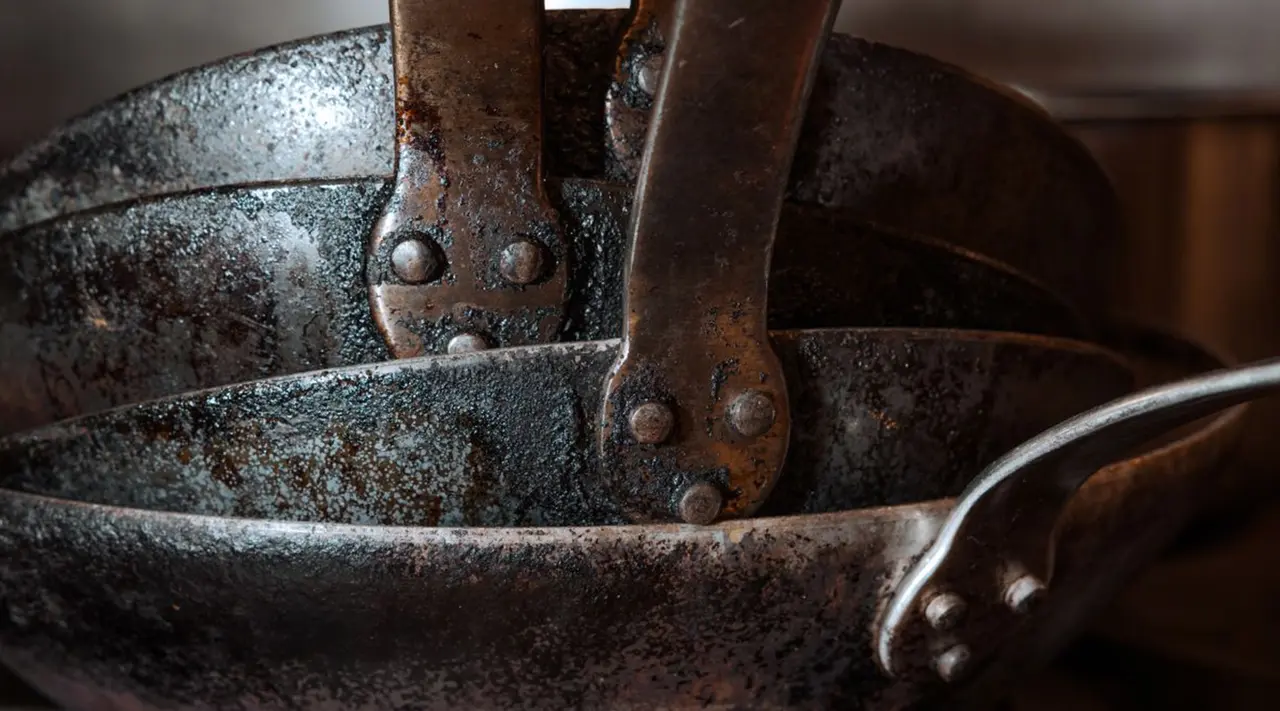Caring for your Made In Cookware is the easiest way to make it last a lifetime. This is especially true of carbon steel cookware, whose seasoning needs special attention in order to maintain its beloved, naturally non stick surface.
From avoiding certain ingredients to following specific cleaning instructions, caring for your wok—or any piece of carbon steel cookware, for that matter—can feel like a large undertaking. But when you know what you’re doing, maintaining carbon steel can be both incredibly simple and worthwhile.
With a little time and the right tips, you’ll be cooking with your wok for years to come. Here, we’ll tell you everything you need to know about cleaning our Carbon Steel Wok.
How to Clean Your Carbon Steel Wok in 3 Steps

Carbon steel heats incredibly quickly, and with the right approach, it can be cleaned even faster. Whether you used your wok to make a veg-forward stir-fry or you deep fried some drumsticks, these step-by-step tips will have your wok clean and ready to cook in no time.
- Gently wipe the wok clean with a paper towel or dish towel once you’ve finished cooking and the pan has cooled. The towel should help you collect any burnt food and remnants and absorb excess oil and fat—and, depending on what you cooked, may be enough to render your pan totally clean.
- If you have food that's stuck or burnt to the pan's surface and requires scrubbing to remove, you'll need a little water to loosen the debris. Gently scrub the residue off with a bristle brush or sponge and a small amount of water.
- If you're still having trouble, add enough water to your pan to cover the residue and return it to the stove to boil. Once the water has reached a boil, use a wooden spoon or spatula to gently scrape at the burnt bits until they're loosened from the pan's surface. Turn off the heat and let the water cool before disposing of it.
- If you used water to clean your wok, be sure it’s totally dry before storing it. We recommend heating your wok on your stove over low-medium heat to expel any lingering moisture, then carefully wiping your pan with a drop or two of a neutral cooking oil to prevent the surface from drying out.
In both cases, make sure that your wok is completely dry before putting it away. Any lingering dampness will damage your seasoning over time or cause rust.
Additional Carbon Steel Wok Care Tips
While cleaning is important, it’s not the only aspect of carbon steel care that matters. If you want your wok to last a lifetime, you’ll need to make sure you’re maintaining a healthy layer of seasoning, preventing or removing rust, and storing your pan in a safe environment. We go into detail on all three below.
How to Season Your Wok
Seasoning is a big part of what makes carbon steel one of the most popular materials in professional kitchens. This polymerized layer of oil is responsible for its naturally non stick surface and an overwhelming amount of flavor.
Scientifically, seasoning is the process of heating a high smoke-point oil on the surface of your pan to create polymerization—the oil and heat react together to form a solid layer, filling in the metal’s small pores. This helps prevent rust and keeps food from sticking during cooking.
Like the rest of our Carbon Steel Collection, the Wok comes preseasoned with a proprietary blend of shea and coconut oil so you're able to cook right out of the box, no initial seasoning required.
The more you cook with your wok, you may notice that your pan’s seasoning is growing thin in areas. This is perfectly normal and easily remedied, as seasoning isn’t a one-and-done experience—it’s a practice you’ll need to keep up throughout the lifespan of your wok. Read up on how (and when) to reseason your carbon steel cookware so you're always prepared.
How to Remove Rust From Your Wok
Sometimes, rust happens. And when it does, it doesn’t mean you need to throw in the towel. In fact, with some vinegar and a little effort, it’ll be good as new.
Carbon steel may rust when left in a moist environment for an extended period of time, or if you live in a particularly humid environment. This happens due to the presence of oxidizable iron in carbon steel’s alloy (which is what also causes cast iron to rust).
But even stubborn rust can be stripped. Our helpful guide will tell you everything you need to know to clean rust from your carbon steel wok.
Store Your Wok Correctly
Because of the potential to rust, it’s essential to store your wok somewhere dry. In addition to wiping it completely dry after cleaning it, you must take care to store it somewhere free of moisture.
The biggest culprits of rusted carbon steel pans are often other pans—if you put a damp stainless pan next to your newly-cleaned wok, the trapped moisture can cause rust or affect the seasoning. For this reason, it’s best practice to ensure that all pans in your cabinet are completely dry before storing them.
Cleaning FAQs
One of the most common questions we receive is whether our Carbon Steel Cookware can go in the dishwasher. The answer is a resounding no—the harsh chemicals found in dishwasher detergent would strip the seasoning.
Have more carbon steel questions? Our carbon steel FAQ guide should have your answer covered.
Ready to Shop?
Our Carbon Steel Wok will ensure you never—at at least, rarely—order takeout again. Endlessly versatile and high-heat friendly, the Carbon Steel Wok will have you making restaurant-quality stir-fry right in your own kitchen.
Need inspiration to decide what you’ll cook first? Check out Chef Eric Silverstein’s go-to Fried Rice with Lap Cheong or explore six unique ways to get to work with your Wok.





























